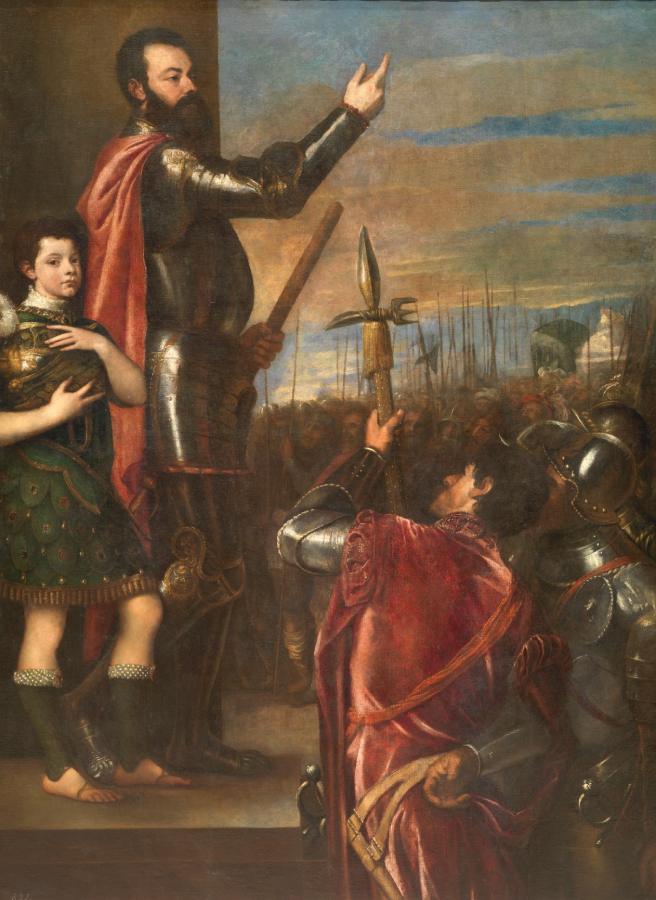Tiziano (c.1488-1576)
Allocuzione di Alfonso d’Avalos (Alfonso d’Avalos Addressing his Troops)
1540–1541
Oil on canvas, 223 cm x 165 cm
Museo del Prado, Madrid
Alfonso d’Avalos, first Marchese del Vasto, was born in Ischia on 25 May 1502 to a noble Neapolitan family of Castilian origins. He fought in Pavia (1525) under the orders of his uncle Fernando d’Avalos, Marchese di Pescara, inheriting his titles and estates on his uncle’s death that same year. In 1535 D’Avalos commanded the army that conquered Tunis and in 1538, he was appointed governor of Milan and commander of the Imperial Army in Italy. His disastrous rule of Milan and the defeat by the French in Ceresola in 1544 marred his prestige and discredited him with the emperor. He died in Vigevano on 31 March 1546.
Although it has been considered a portrait of D’Avalos, The Allocution is in fact a history painting recording an event that took place in 1537 recounted by Paolo Giovio in book XXXVII of his Historia sui temporis. It relates how D’Avalos ended a mutiny of troops stationed in Lombardy through his noble and military eloquence. In late 1539 D’Avalos travelled to Venice with Giovio and commissioned The Allocution from Titian, who had already painted his portrait in 1531 through the offices of Aretino (Paris, Louvre). The fact that D’Avalos, one of the most celebrated military figures of his day, should chose to commemorate such a prosaic event can be explained by political motives. The Allocution is a plea in defence of his conduct during the events of 1537, directed at the Milanese, annoyed at having had to provide the money to calm the unruly troops, and at the emperor, who had criticised his concessions to the troops in contrast to the firmness shown in a similar situation by Ferrante Gonzaga. Through this work D’Avalos emphasised his skill in having put down such an uprising in a peaceful manner and his sacrifice in having left his son, Francesco Ferrante (the boy with the helmet) as a hostage to guarantee his promises. For sixteenth-century humanists, the adlocutio also signified the loyalty of troops to their commander, making the painting a reaffirmation of D’Avalos‘s position at the head of the imperial army. The propagandistic intentions of the painting were obvious when it was exhibited publicly on its arrival in Milan in the summer of 1541, coinciding with Charles V‘s visit to the city. Satisfied with the result, D’Avalos awarded Titian (who had personally delivered the painting) an annual pension of 50 ducats.
In representing D’Avalos‘s intentions, Titian successfully united contemporary history and the classical world. The theme of the adlocutio was a classical one, commonly found in Roman art and history and Titian represented it in a classical manner, with D’Avalos exhorting the troops from a platform or suggestus, capturing their attention with his raised right arm, as recommended in manuals on oratory. The context in which the work was produced also emphasises the importance of classical references. D’Avalos heard about the painting’s progress through Aretino, who did not hesitate to compare him with Julius Caesar and whose role as intermediary is recorded in the painting as Titian depicts him as the soldier in the cuirass immediately behind the pike-bearer in the foreground.
The design of the composition also drew on numerous Roman models, such as the reliefs on the Arch of Constantine (referred to by Aretino in his November letter) and a coin of Gordian III (about 424 AD). From the late fifteenth century, the adlocutio was a commonly represented subject in Italian art: one precedent is Giulio Romano’s Allocution of Constantine in the Vatican which Titian would have known through his contacts with Giulio in Mantua. In Venice the adlocutio was a subject in art from the mid-fourteenth century, as we can see in an equestrian adlocutio of Julius Caesar in a manuscript of De vita Caesarum by Suetonius (Fermo, Biblioteca Comunale, Cod. 81). Other elements in the painting are contemporary references, such as D’Avalos‘s armour, copied from a suit of armour by Girolamo Martinengo of Brescia, from whom Aretino requested it on 15 February 1541, or the figure of the pike-bearer with his back to us, taken from one of Dürer‘s prints in the Great Passion series. Both this figure and that of Aretino as well as D’Avalos himself reappear in the Ecce Homo that Titian painted for Johannes de Haana in 1543. For the figure of D’Avalos, Titian reworked his Saint Nazarus from the Averoldi Polyptych.
(Falomir Faus, Miguel, Tiziano, Madrid, Museo Nacional del Prado, 2003, p.186)
See also:
• Alfonso d’Avalos d’Aquino, Marquis of Vasto and Pescara (1502-1546)
